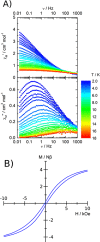Magnetic Memory from Site Isolated Dy(III) on Silica Materials
- PMID: 28386602
- PMCID: PMC5364447
- DOI: 10.1021/acscentsci.7b00035
Magnetic Memory from Site Isolated Dy(III) on Silica Materials
Abstract
Achieving magnetic remanence at single isolated metal sites dispersed at the surface of a solid matrix has been envisioned as a key step toward information storage and processing in the smallest unit of matter. Here, we show that isolated Dy(III) sites distributed at the surface of silica nanoparticles, prepared with a simple and scalable two-step process, show magnetic remanence and display a hysteresis loop open at liquid 4He temperature, in contrast to the molecular precursor which does not display any magnetic memory. This singular behavior is achieved through the controlled grafting of a tailored Dy(III) siloxide complex on partially dehydroxylated silica nanoparticles followed by thermal annealing. This approach allows control of the density and the structure of isolated, "bare" Dy(III) sites bound to the silica surface. During the process, all organic fragments are removed, leaving the surface as the sole ligand, promoting magnetic remanence.
Conflict of interest statement
The authors declare no competing financial interest.
Figures



References
-
- Sessoli R.; Gatteschi D.; Caneschi A.; Novak M. A. Magnetic Bistability in a Metal-Ion Cluster. Nature 1993, 365, 141–143. 10.1038/365141a0. - DOI
-
- Gao S.; Affronte M.; Baker M. L.; Blundell S.; Bogani L.; Chibotaru L. F.; Clérac R.; Cornia A.; Coulon C.; Domingo N.. Molecular nanomagnets and related phenomena; Springer: 2015.
-
- Holmberg R. J.; Murugesu M. Adhering magnetic molecules to surfaces. J. Mater. Chem. C 2015, 3, 11986–11998. 10.1039/C5TC03225C. - DOI
LinkOut - more resources
Full Text Sources
Other Literature Sources

